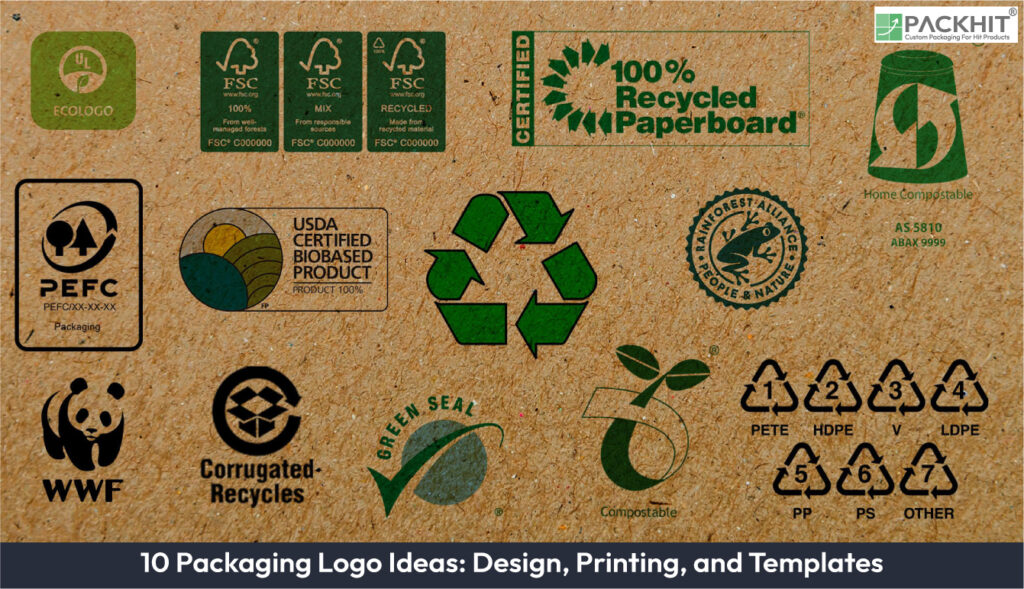Packaging logos serve as critical visual identifiers for brands, combining design aesthetics, printing techniques, and template adaptability to create impactful branding on product packaging. Packaging logo ideas can be categorized into three primary approaches: design, printing, and templates. Design-focused logos emphasize visual storytelling through minimalism, iconic symbols, or typography, ensuring they align with brand identity. Printing techniques such as embossing, foil stamping, and digital printing add texture, vibrancy, and precision to logo applications, enhancing both functionality and appeal. Templates offer scalable and adaptable solutions, allowing logos to be seamlessly incorporated into various packaging formats, from labels and die-cuts to wraparound designs. These strategies provide manufacturers with diverse options to create impactful, recognizable packaging logos tailored to their products and consumer preferences.
The ten packaging logo ideas categorized into three main approaches, design, printing, and templates, are given below.
- Minimalist Logo Designs
- Symbol-Based Logos
- Typography-Driven Logos
- Embossing and Debossing
- Foil Stamping
- Digital Printing
- Die-Cut Templates
- Label Templates
- Wraparound Templates
- Interactive Templates
1. Minimalist Logo Designs
Minimalist logos emphasize simplicity through clean lines, geometric shapes, and limited color palettes. These designs are particularly effective for luxury and eco-friendly brands, as they convey sophistication and sustainability. For example, a monochromatic logo printed on kraft paper packaging can enhance the perception of environmental consciousness.
2. Symbol-Based Logos
Symbol-based logos utilize iconic imagery to represent brand values or product attributes. Industries such as food and cosmetics often employ symbols like leaves, water droplets, or abstract shapes to evoke freshness or purity. These logos are versatile and can be scaled across various packaging formats without losing clarity.
3. Typography-Driven Logos
Typography-driven logos focus on custom fonts and stylized text to create a distinctive brand identity. Serif fonts are commonly used for traditional or artisanal brands, while sans-serif fonts suit modern and tech-oriented products. Combining typography with subtle graphic elements can further enhance visual appeal.
4. Embossing and Debossing
Embossing and debossing add tactile depth to logos by creating raised or recessed impressions on packaging surfaces. These techniques are ideal for premium brands seeking to enhance the sensory experience of their products. For instance, embossed logos on rigid boxes can elevate the perceived value of high-end goods.
5. Foil Stamping
Foil stamping applies metallic or holographic finishes to logos, creating a striking visual effect. This method is widely used in industries such as cosmetics and beverages to attract attention and convey luxury. Gold or silver foil logos on dark packaging backgrounds are particularly effective in achieving high contrast.
6. Digital Printing
Digital printing offers flexibility and precision, allowing manufacturers to reproduce intricate logo designs with high color accuracy. This technique is suitable for small-batch production and personalized packaging, as it eliminates the need for costly setup processes. Digital printing is often used for e-commerce packaging to accommodate variable designs.
7. Die-Cut Templates
Die-cut templates allow logos to be incorporated into unique packaging shapes, such as window cutouts or custom box designs. This approach is particularly effective for showcasing products while maintaining brand visibility. For example, a die-cut logo on a transparent sleeve can highlight the product inside while reinforcing brand identity.
8. Label Templates
Label templates provide a versatile solution for applying logos to various packaging types, including bottles, jars, and pouches. These templates can be customized to include additional branding elements such as taglines or QR codes. Labels are cost-effective and suitable for small businesses seeking scalable branding solutions.
9. Wraparound Templates
Wraparound templates enable logos to span the entire surface of cylindrical or rectangular packaging. This design maximizes visibility and creates a cohesive branding experience. Industries such as beverages and cosmetics often use wraparound templates to create visually immersive packaging.
10. Interactive Templates
Interactive templates incorporate elements such as augmented reality (AR) markers or scannable codes into logo designs. These templates enhance consumer engagement by linking physical packaging to digital content, such as promotional videos or product information. Interactive logos are increasingly popular in tech-savvy markets.
How Can Manufacturers Optimize Packaging Logo Strategies?
To optimize packaging logo strategies, manufacturers should consider the following factors:
- Material Compatibility: Ensure logo designs and printing techniques align with the packaging material to maintain durability and aesthetic appeal.
- Brand Consistency: Use templates to standardize logo placement and design across all packaging formats.
- Cost Efficiency: Select printing methods and templates that balance quality with production costs, especially for large-scale manufacturing.
- Consumer Trends: Incorporate emerging trends such as eco-friendly designs and interactive logos to meet evolving consumer preferences.
By integrating creative design concepts, advanced printing techniques, and adaptable templates, manufacturers can create packaging logos that not only enhance brand recognition but also align with market demands and production capabilities.

